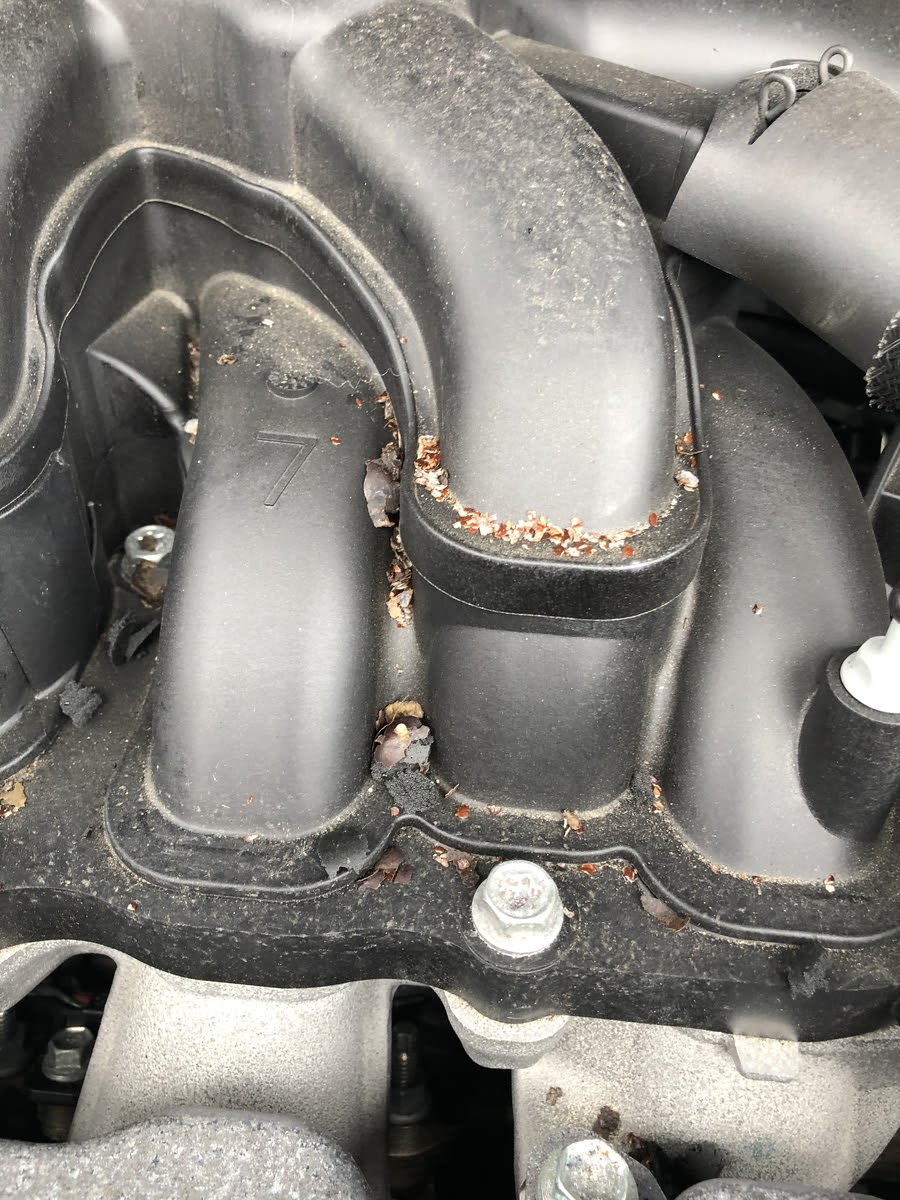As an Amazon Associate, I earn from qualifying purchases at no extra cost to you.
How to Troubleshoot “Check Awd System” in Toyota Highlander?
To troubleshoot “Check AWD System” in a Toyota Highlander, start by checking the AWD fuse. If the fuse is intact, consider inspecting the sensors and control unit for any issues that may be triggering the warning message.
It is important to address the problem promptly to ensure optimal performance and safety of your vehicle. When your Toyota Highlander displays the “Check AWD System” warning, it can be concerning. However, by following some basic troubleshooting steps, you may be able to identify and resolve the underlying issue.
We will explore some common reasons why this warning may appear and provide you with practical tips on how to troubleshoot and potentially fix the problem. By understanding the components of the AWD system and knowing what to look for when troubleshooting, you can effectively address any issues and keep your Toyota Highlander running smoothly.
Understanding The Awd System
Awd System Overview
Toyota Highlander’s AWD System functions to distribute power to all four wheels for enhanced traction and stability.
The system engages automatically when slip is detected, ensuring optimal performance in various driving conditions.
Awd System Components
Main components:
- Transfer Case: Distributes power to front and rear axles
- Rear Differential: Transfers power between the rear wheels
- Front Differential: Controls power distribution to the front wheels
Proper maintenance of these components is crucial for the AWD system’s efficiency and longevity.

Credit: www.reddit.com
Common Causes Of ‘check Awd System’ Warning
When the ‘Check AWD System’ warning appears on your Toyota Highlander, it can be a cause for concern. This warning is an indication that there’s an issue with the all-wheel drive system of your vehicle. Ignoring this warning can lead to further damage and potentially unsafe driving conditions. In order to resolve the problem and get your Highlander back on the road, it’s important to understand the common causes behind this warning.
Wheel Speed Sensor Issues
One of the common reasons for the ‘Check AWD System’ warning in Toyota Highlanders is the malfunction of the wheel speed sensors. These sensors are responsible for detecting the rotational speed of each wheel and sending the information to the vehicle’s computer system. When a sensor fails or becomes damaged, it can disrupt the communication between the wheels and the AWD system, triggering the warning. Regular maintenance and inspections can help identify and resolve any issues with wheel speed sensors to prevent this warning from appearing.
Fluid Leaks Or Contamination
Another potential cause of the ‘Check AWD System’ warning is fluid leaks or contamination within the system. The AWD system relies on various fluids, such as transmission fluid or differential fluid, to function properly. If there is a leak or if the fluid becomes contaminated with debris or dirt, it can affect the performance of the AWD system and trigger the warning. Regular fluid checks and maintenance can help prevent leaks and ensure the fluids are clean and at the appropriate levels.
Identifying and addressing these common causes of the ‘Check AWD System’ warning can help you troubleshoot the issue with your Toyota Highlander. However, it’s important to remember that these are general causes, and the specific problem may vary. If you’re unsure or unable to resolve the issue on your own, it’s recommended to consult a professional mechanic or take your Highlander to a certified Toyota service center for further inspection and repair.
Also Read: Meaning of “Sr5” in Toyota Vehicles?
Initial Steps To Diagnose
To diagnose the “Check Awd System” in a Toyota Highlander, begin by checking the dashboard warning light to identify the problem. Use an OBD-II scanner to retrieve error codes from the vehicle’s computer. Inspect the AWD system components, including the sensors, wiring, and connections, for any visible damage or issues.
When your Toyota Highlander displays the “Check Awd System” message on the dashboard, it’s essential to take immediate action to identify and resolve the issue. Through a systematic process of troubleshooting, you can pinpoint the underlying problem and potentially save yourself from expensive repairs. In this section, we will look at the initial steps you can take to diagnose the “Check Awd System” warning in your Toyota Highlander.
Check Dashboard Messages
Start by checking the dashboard messages on your Toyota Highlander. The “Check Awd System” warning is often accompanied by other relevant alerts. Look for any additional warnings relating to the ABS (Anti-lock Braking System) or the Vehicle Stability Control (VSC) system. These messages can provide valuable clues about the specific issue affecting your vehicle’s AWD system.
Vehicle Inspection
Once you have noted any relevant dashboard messages, it’s time to conduct a thorough inspection of your vehicle. Inspecting the various components related to the AWD system can help identify any visible issues that may be causing the warning message.
Here are some important areas to focus on during your inspection:
- Check the tire pressure and tread depth on all four tires. Uneven tire pressure or excessive wear can affect the performance of the AWD system.
- Inspect the wheel speed sensors located on each wheel. Ensure they are clean and free from any debris.
- Examine the wiring connections that link the various components of the AWD system. Look for any loose or damaged wires that may be causing a disruption in the system.
If you notice any visible issues during your inspection, such as a loose wire or low tire pressure, try addressing these problems first. Sometimes, a simple fix can resolve the “Check Awd System” warning.
If the dashboard messages and vehicle inspection do not provide a clear solution, it’s advisable to seek professional assistance. Consulting with a certified Toyota technician will ensure that your vehicle is thoroughly diagnosed and repaired.

Credit: www.reddit.com
See Also: Reliability of Toyota Cvt Transmissions?
Diagnostic Tools And Their Uses
An OBD-II scanner is a diagnostic tool that plugs into the vehicle’s onboard computer to retrieve error codes.
It can be used to read and clear codes related to the AWD system in a Toyota Highlander.
OBD scanners are efficient for quick diagnosis and can provide real-time data for troubleshooting.
An All-Wheel Drive System Tester is a specialized tool designed to test the components of the AWD system.
This tool can simulate different driving conditions to identify potential issues with the AWD system.
It provides detailed insights into the functioning of the AWD system to pinpoint problems accurately.
Inspecting Awd System Components
When troubleshooting the “Check AWD System” warning in your Toyota Highlander, inspecting the AWD system components is crucial for identifying and resolving potential issues. By thoroughly examining the wheel speed sensors, transfer case, and rear differential, you can pinpoint the source of the problem and take the necessary steps to rectify it.
Checking Wheel Speed Sensors
Begin by inspecting the wheel speed sensors to ensure they are functioning properly. These sensors play a vital role in transmitting data to the AWD system, allowing it to adjust power distribution effectively. Look for any signs of damage, corrosion, or disconnection. Clean the sensors and their connecting terminals to eliminate any potential issues caused by dirt or debris.
Inspecting Transfer Case And Rear Differential
Next, direct your attention to the transfer case and rear differential. These components are integral to the AWD system, facilitating the distribution of power to all four wheels. Check for any leaks, unusual noises, or abnormal vibrations that may indicate a problem. Additionally, inspect the fluid levels and quality in both the transfer case and rear differential, ensuring they are within the manufacturer’s recommended specifications.
Repairing Common Awd System Issues
If your Toyota Highlander displays a “Check AWD System” warning, you can troubleshoot common issues by checking the fluid levels, inspecting the drivetrain components, and scanning for diagnostic trouble codes with a professional scanner. Regular maintenance and timely repairs can help address and prevent AWD system problems, ensuring the vehicle’s optimum performance.
Repairing Common AWD System IssuesYour Toyota Highlander’s AWD system can sometimes throw a “Check AWD System” warning on your dashboard, indicating potential issues that need prompt attention. To help you troubleshoot and resolve these problems, it’s essential to be aware of common AWD system issues and their possible solutions.#### Replacing Faulty Wheel Speed SensorIf you encounter the “Check AWD System” warning, check the wheel speed sensors for any malfunctions. These sensors play a crucial role in monitoring the speed of each wheel, enabling the AWD system to adjust power distribution accordingly. A faulty wheel speed sensor can disrupt this process, leading to the warning light. If you suspect a faulty sensor, it’s prudent to replace it with a genuine Toyota part. Here's how to do it:1. Locate the faulty sensor by referring to your vehicle’s manual or seeking professional assistance. 2. Carefully detach the old sensor, taking note of its position and connections. 3. Install the new sensor, ensuring it's securely in place and the connections are properly attached.#### Addressing Fluid Leaks or ContaminationFluid leaks or contamination in the AWD system can also trigger the “Check AWD System” warning. Start by identifying the source of the leak and the type of fluid involved. Common culprits include transmission fluid, differential fluid, or transfer case fluid. Once you pinpoint the issue, take the necessary steps to resolve it:– Inspect the affected components, such as seals, gaskets, and connections, for signs of leaks or contamination. – Clean the area thoroughly to accurately identify the source of the issue. – Replace any damaged seals, gaskets, or components with OEM parts to prevent future leaks or contamination.By addressing these common AWD system issues, you can effectively troubleshoot the “Check AWD System” warning on your Toyota Highlander and ensure optimal performance for your vehicle.Professional Assistance And Maintenance
Professional assistance and maintenance are crucial when dealing with the “Check AWD System” issue in your Toyota Highlander. Consulting a certified technician and scheduling regular AWD system check-ups can help ensure optimal performance and safety of your vehicle.
Consulting A Certified Technician
When the “Check AWD System” warning appears, seek expert advice from a certified technician to diagnose and resolve the issue accurately.
Regular Awd System Check-ups
Maintain the health of your AWD system by scheduling routine check-ups to detect and address any potential problems early on.

Credit: www.cargurus.com
Preventive Measures To Avoid ‘check Awd System’ Warning
In order to avoid the ‘Check AWD System’ warning in your Toyota Highlander, it is vital to follow some crucial preventive measures. By taking the time to incorporate routine maintenance and safe driving practices into your routine, you can significantly reduce the likelihood of encountering this issue. In this section, we will discuss these preventative measures in detail.
Routine Maintenance
Maintaining your Toyota Highlander is essential to prevent the ‘Check AWD System’ warning from appearing. By staying on top of routine maintenance tasks, you can ensure that your vehicle’s AWD system functions optimally. Here are some important routine maintenance steps to consider:
- Regularly check and change the differential fluid as per the manufacturer’s recommendations.
- Inspect the condition of the tires, ensuring proper tread depth and inflation levels.
- Replace worn-out tires promptly to maintain proper traction and balance.
- Regularly inspect the wheel bearings and suspension components for any signs of wear or damage.
- Keep the AWD system’s electrical connections clean and free from corrosion.
By following these routine maintenance steps, you can keep your Toyota Highlander’s AWD system in excellent condition and minimize the chances of the ‘Check AWD System’ warning appearing.
Safe Driving Practices
In addition to routine maintenance, practicing safe driving habits is crucial to prevent the ‘Check AWD System’ warning from occurring. The way you drive plays a significant role in the health of your vehicle’s AWD system. Here are some safe driving practices to integrate into your routine:
- Avoid aggressive driving and sudden accelerations or decelerations.
- Be mindful of road conditions and adjust your speed accordingly to prevent excessive strain on the AWD system.
- Refrain from making sharp turns at high speeds, as this can put unnecessary stress on the AWD system components.
- Avoid driving through deep water or off-road areas unless your Toyota Highlander is equipped for such conditions.
- Always follow the manufacturer’s guidelines for towing capacity to prevent overloading.
By adopting these safe driving practices, you can reduce the risk of encountering the ‘Check AWD System’ warning. Remember, proactive measures go a long way in maintaining the integrity of your Toyota Highlander’s AWD system.
Conclusion
To conclude, troubleshooting the “Check AWD System” in your Toyota Highlander is essential for maintaining optimal vehicle performance. By following the steps outlined in this guide, you can effectively identify and address any issues related to the AWD system. Remember to consult a professional if you encounter persistent problems.
Ensuring the health of your AWD system will contribute to a smoother and safer driving experience.


